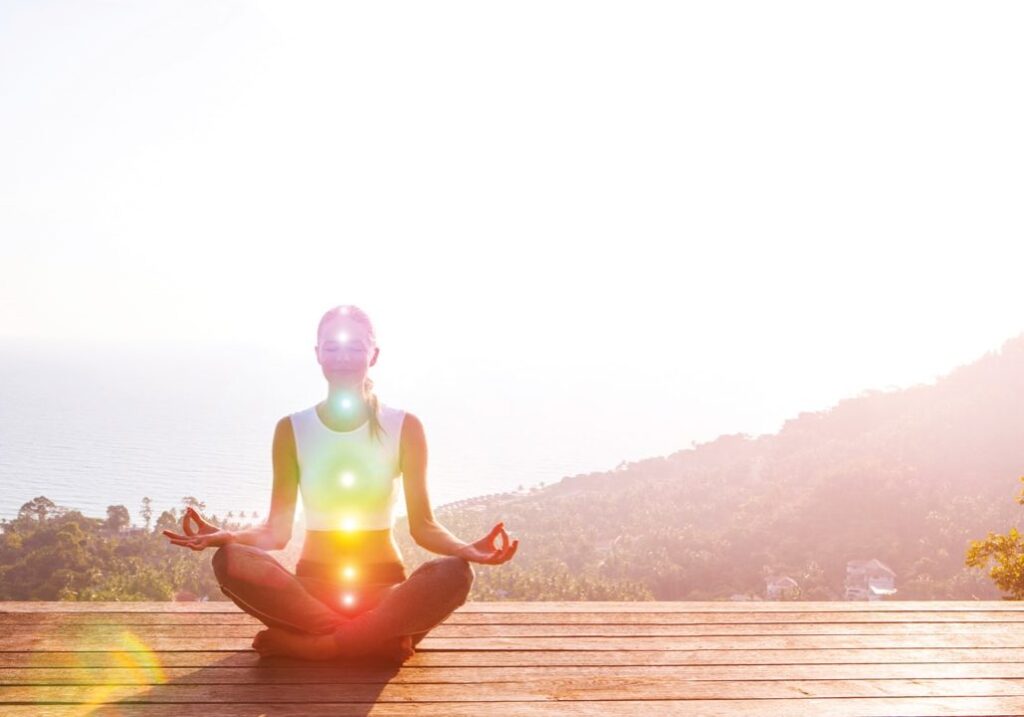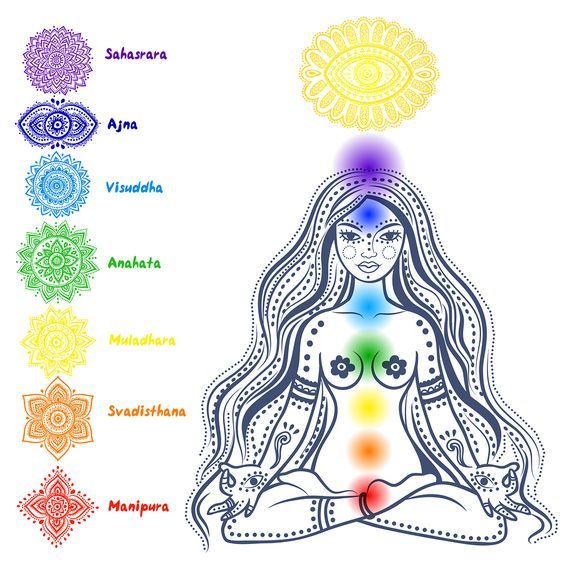Chakras 101: An Introduction to the 7 Chakras

You may have heard about chakra healing and chakra balancing, but what does it mean exactly? This post will break down what the chakras are, what they represent, and how they impact our minds, bodies, and lives.
To start, it’s important to know that each chakra is represented by a specific color, name, and location in the body. There are seven chakras in the body, each one located at a specific area, and each one representing an aspect of our energetic being.
Each chakra is connected to a different aspect of ourselves, and as a result, each one impacts different parts of our well-being on a physical, emotional, and energetic level. Read on to learn everything you need to know about the chakra system.
Chakra Introduction and Overview
The seven chakras are part of the subtle body, or the energetic body. It’s the part that we can’t see or touch but can always feel. It’s the part of us that makes the heart beat, the piece of us that feels a gut intuition, and the energy within us that creates our being.
The word Chakra in Sanskrit means “disk” or “wheel.” The chakras are like spinning vortexes or energy centers that contain and process the life force energy moving through our bodies.
This life force energy runs along channels that are like an energetic highway within us, and your energy is like the vehicle traveling along those highways. The main energy channel runs from the base of the spine (the Root Chakra), to the crown of the head (the Crown Chakra), and then beyond.
When our energy travels along these channels, we want it to travel along smoothly, getting from point A to point B without any traffic jams. Just like there are exits along the highway, there are exits off the energetic highway, and these are known as the chakras.
When everything is working—the highway is open and the channels are clear, the exits are functioning and balanced—it allows the energy to flow freely and smoothly, and you may feel balanced and in harmony with your life. When things are not working and we have a traffic jam on our highway, the exits can get blocked, and the energy gets stuck. This misalignment can make different aspects of our life challenging, and it can have a huge impact on our physical, mental, emotional, and spiritual health.
Knowing which areas of the body are connected to which chakra can give you clues about what you might need to unblock or heal, and even bring you to focus on parts of yourself you were unaware needed healing.

The 7 Chakras
Let’s break down the chakra system and explore each individual chakra, its attributes, associations, and more.
The Root Chakra (Muladhara)
The Root or Muladhara Chakra is the first wheel of energy and it begins at the base of the spine.
This chakra is associated with the earth element and is directly linked to the roots we’ve planted – how deep they are, how strong they are, and how supportive they are. The Muladhara Chakra symbolizes root or fundamental issues: shelter, safety, security, water, food, and family. It represents what we need to survive in the physical world.
When this chakra is balanced, we feel grounded, secure, safe, and stable. Our lives flow with a calm and steady energy when we feel our basic needs are met.
When out of alignment, life becomes difficult. We feel insecure, fearful, and anxious. Our fight-or-flight instinct may be turned on. This imbalance can lead to weight gain, constipation, and lower back pain.
Location: Base of the spine
Color: Red
Mantra: LAM
Element: Earth
Chakra Mantra: “It is safe for me to be here.”
Read more about the the Root Chakra here.
The Sacral Chakra (Swadhisthana)
The Svadhisthana or Sacral Chakra is the second wheel of energy and represents our emotional well-being, creativity, passion, and sexual energy within the body.
The Svadhisthana Chakra is associated with the element of water. When water comes to mind, we imagine fluidity, flow, and movement. The second chakra carries an enthusiastic, joyful vibration.
When this chakra is balanced, life is filled with an abundance of vitality, creativity, passion, and fulfilling relationships. You have a strong sense of worthiness and are able to express your desires.
When out of alignment, you can experience emotional instability, a need for control, shame and guilt, sexual dysfunction, and a lack of creative energy. You may experience low back pain, UTIs, reproductive issues, and other pelvic-lower issues.
Location: Above the pubic bone and below the navel
Color: Orange
Mantra: VAM
Element: Water
Chakra Mantra: “I flow with the rhythms of life.”
Read more about the sacral chakra here.
The Solar Plexus Chakra (Manipura)
The Manipura or Solar Plexus Chakra is the third wheel of energy and is associated with the element of fire.
This chakra represents our personal power, governs our self-worth, personal identity, and our drive and energy. It is our inner fire.
When this chakra is balanced, you’ll find that self-confidence, a sense of purpose, and motivation are present in your life. When presented with an issue, you’re decisive, self-disciplined, and in control of your life.
When out of alignment, you can experience heartburn, digestion issues, and eating disorders. You might feel low self-esteem, insecurity, a lack of energy, and may have difficulty making decisions.
Location: The navel area, from the solar plexus up to the breastbone
Color: Yellow
Mantra: RAM
Element: Fire
Chakra Mantra: “I am strong, powerful, and confident.”
The Heart Chakra (Anahata)
The Heart Chakra is the fourth wheel of energy and is the bridge between the lower chakras (the physical) and the upper chakras (the spiritual).
By balancing and aligning the first three chakras, we generate enough self-love to integrate and open the heart chakra, signaling we are ready to move into the higher frequencies of the upper chakras.
The fourth chakra represents everything that involves love, forgiveness, compassion, and joy. It’s one of the most beautiful yet emotional chakras for people to tap into.
When this chakra is balanced, you feel loving, compassionate, full of gratitude, and able to forgive and accept others (and yourself). You are able to process your emotions in a healthy way.
When out of alignment, you can experience poor circulation, breathing disorders, heart problems, pain in the upper back, and you may feel loneliness, depression, jealousy, codependence, judgmental and overly critical, and generally closed off to others and life.
Location: Center of the chest (including the heart, lungs, and entire surrounding area)
Color: Green
Mantra: YAM
Element: Air
Chakra Mantra: “My heart is open to giving and receiving.”
The Throat Chakra (Vishuddha)
The Vishuddha or Throat Chakra is the fifth wheel of energy and it’s the first of the three spiritual chakras.
The Throat Chakra is associated with ether, or a space-like quality that symbolizes an open voice from where authenticity and truthfulness can flow.
The fifth chakra represents your ability to speak your truth, express ideas clearly, and speak up for yourself and set clear boundaries. You are honest, and understand that clear communication is not only about speaking, but about listening as well. Because it’s the first of the spiritual chakras, the lower four chakras must also be in balance.
When this chakra is balanced, you speak, listen, and express yourself through a higher form of communication and authenticity.
When out of alignment, you can experience a fear of speaking out, to ask for what you need, want or desire, you may talk too much or too little, spread gossip, or engage in negative self-talk. Physical symptoms can manifest in a sore throat, thyroid problems, jaw tension and TMJ, and neck/shoulder pain.
Location: The throat
Color: Blue
Mantra: HAM
Element: Ether
Chakra Mantra: “It is safe for me to express my authentic self.”
The Third Eye Chakra (Ajna)
The most popular and well-known of the chakras, the Third-Eye Chakra is the sixth wheel of energy and it represents our intuition or sixth sense. It is the second of the higher or spiritual chakras and serves as our center for creative visualization and manifestation, along with how we perceive the exterior world as well as our own interior dialogue.
When this chakra is balanced, you are able to connect with and trust your intuition, see through illusion, have a vast imagination, a strong memory, and you are focused.
When out of alignment, you may feel unclear, unwilling to trust your intuition, cynical, too attached to logic, and have a lack of imagination. Physical symptoms might be problems with vision, headaches and migraines, hormone imbalances, and nightmares or insomnia.
Location: The space between the eyebrows
Color: Indigo
Mantra: OM
Element: Light
Chakra Mantra: “I am awake.”
The Crown Chakra (Sahasrara)
The Sahasrara or Crown Chakra is the seventh and final chakra. It represents our divinity. This chakra represents that you are a spiritual being having a human experience on this Earth.
When working on this chakra, you’re acknowledging to yourself and the world that you are ready to dissolve separation and cultivate an acceptance of all, and that you are ready to transcend the physical world for a more spiritual experience.
When this chakra is balanced, you feel at peace, like you have an open mind, that you are connected to the Universe and to your higher self.
When out of alignment, you may feel closed-minded, feelings of superiority, scatter-brained and ungrounded, or like you’re living up in the clouds. Physical symptoms related to the crown chakra might be headaches and migraines, mental disorders, nervous system imbalances, epilepsy, and Alzheimer’s disease.
Location: Outside the body and hovering above the crown of the head
Color: Violet or White
Mantra: Silence
Element: Consciousness
Chakra Mantra: “I am one with the Universe.”
Align With Your Chakras to Create Balance in Your Life
Now that we’ve explained and explored the Chakra system, here’s the best way to digest it all:
Read through each chakra and what it represents. By learning the chakra system and how to become more introspective, we’re able to think about some of the issues we’re having and identify where we’re not feeling balanced and which energy center the imbalance is coming from. Then we can work on that specific area and hopefully alleviate some of these issues and bring ourselves back into balance.
Choose to start with one or two of the chakras you are drawn to, and begin to focus on, strengthen, and balance that energy. Working on healing and balancing our chakras is a lifelong journey, but in time, you’ll slowly learn what your energetic body needs and how best to implement practices to help keep it in balance.
Start your transformative journey today by exploring the world of chakras.
Take the chakra test to identify any imbalance and find ways to heal and open your chakras.
If you want to go deeper into working with the chakras, try the free 7 day Chakra Healing Challenge or sign up for the online Energy Healing Workshop and embrace the power of chakra balance through meditation, healing practices, and working with chakra stones for a more aligned and energized life.
Do you know which chakra is your strongest? Share in the comments below.
For promitions, inspiration, and exclusive content delivered to your inbox, sign up for The Ascension Studio newsletter.
If you’d like more inspiration, come join me on Instagram.
Lots of love + light…thank you for reading.

OWpSe wryUISUj pQnazyyp YEsTmccz jwRHhHi ggB ULu